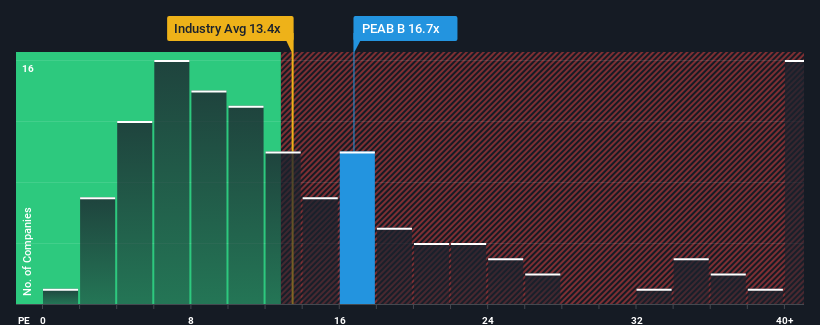- Sweden
- /
- Construction
- /
- OM:PEAB B
Peab AB (publ)'s (STO:PEAB B) Shares Lagging The Market But So Is The Business

With a price-to-earnings (or "P/E") ratio of 16.7x Peab AB (publ) (STO:PEAB B) may be sending bullish signals at the moment, given that almost half of all companies in Sweden have P/E ratios greater than 24x and even P/E's higher than 45x are not unusual. Although, it's not wise to just take the P/E at face value as there may be an explanation why it's limited.
While the market has experienced earnings growth lately, Peab's earnings have gone into reverse gear, which is not great. It seems that many are expecting the dour earnings performance to persist, which has repressed the P/E. If this is the case, then existing shareholders will probably struggle to get excited about the future direction of the share price.
Check out our latest analysis for Peab

Does Growth Match The Low P/E?
There's an inherent assumption that a company should underperform the market for P/E ratios like Peab's to be considered reasonable.
Taking a look back first, the company's earnings per share growth last year wasn't something to get excited about as it posted a disappointing decline of 43%. This means it has also seen a slide in earnings over the longer-term as EPS is down 54% in total over the last three years. Therefore, it's fair to say the earnings growth recently has been undesirable for the company.
Shifting to the future, estimates from the four analysts covering the company suggest earnings should grow by 12% each year over the next three years. Meanwhile, the rest of the market is forecast to expand by 19% each year, which is noticeably more attractive.
With this information, we can see why Peab is trading at a P/E lower than the market. It seems most investors are expecting to see limited future growth and are only willing to pay a reduced amount for the stock.
What We Can Learn From Peab's P/E?
Generally, our preference is to limit the use of the price-to-earnings ratio to establishing what the market thinks about the overall health of a company.
We've established that Peab maintains its low P/E on the weakness of its forecast growth being lower than the wider market, as expected. Right now shareholders are accepting the low P/E as they concede future earnings probably won't provide any pleasant surprises. Unless these conditions improve, they will continue to form a barrier for the share price around these levels.
You should always think about risks. Case in point, we've spotted 3 warning signs for Peab you should be aware of.
If you're unsure about the strength of Peab's business, why not explore our interactive list of stocks with solid business fundamentals for some other companies you may have missed.
New: Manage All Your Stock Portfolios in One Place
We've created the ultimate portfolio companion for stock investors, and it's free.
• Connect an unlimited number of Portfolios and see your total in one currency
• Be alerted to new Warning Signs or Risks via email or mobile
• Track the Fair Value of your stocks
Have feedback on this article? Concerned about the content? Get in touch with us directly. Alternatively, email editorial-team (at) simplywallst.com.
This article by Simply Wall St is general in nature. We provide commentary based on historical data and analyst forecasts only using an unbiased methodology and our articles are not intended to be financial advice. It does not constitute a recommendation to buy or sell any stock, and does not take account of your objectives, or your financial situation. We aim to bring you long-term focused analysis driven by fundamental data. Note that our analysis may not factor in the latest price-sensitive company announcements or qualitative material. Simply Wall St has no position in any stocks mentioned.
About OM:PEAB B
Peab
Operates as a construction and civil engineering company in Sweden, Norway, Finland, Denmark, and internationally.
Undervalued with excellent balance sheet and pays a dividend.
Similar Companies
Market Insights
Community Narratives



